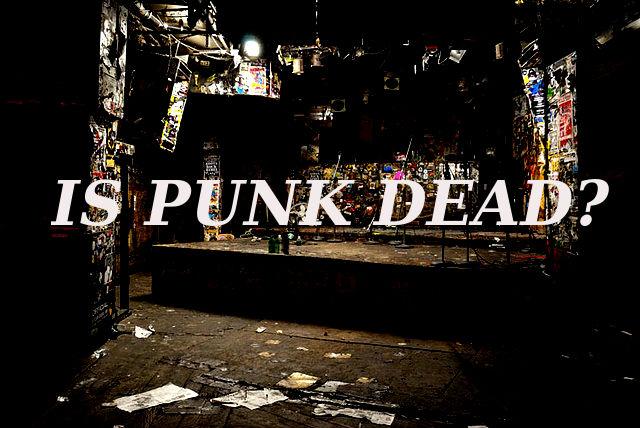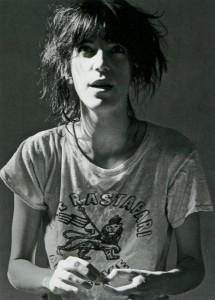Punk is still partying hard, just look harder


by Hannah Zeitner, staff reporter
The mainstream media likes to say that punk is dead or that punk went pop. Others say that punk is just sleeping off a bad hangover (which apparently has lasted since the late 90’s). Has there actually been a headstone put up reading “R.I.P Punk?”
There are bands right now that identify their music under the punk rock genre, but punk music and punk itself are two different ideas that intertwine.
When one would think of punk music, bands like Black Flag, The Clash, Dead Kennedys, Talking Heads, Ramones, Germs, Bad Brains, Bikini Kill could come to mind; the list goes on and on. CBGB or Gilman could come to mind. But what is the idea of ‘punk’ all about?
What is Punk? (The Idea of it All)
Destruction? Doing the opposite of what the mainstream tells you to do? Spikes, studs, fuzzy peach sweaters? Loving, hating, fighting, piercing your nose with a baby pin? Every person has a different definition of what “punk” is.
As a noun, the Merriam Webster Dictionary defines punk as “A rude and violent young man.”
According to John Holmstrom, founder and editor of Punk Magazine says that “Punk is that spirit of rebellion that manifests in dressing opposite of how you’re supposed to, thinking like they tell you, etc.” He also notes that the idea of punk also has to do with the feeling of wanting to go against authority.
Off of a Flavorwire article, “What is Punk? 25 Definitions from People Who Should Know,” title meaning that the people who the site received quotes from were or are still part of the punk movement. There are a couple of definitions about what they think punk is that stand out:
“Undermine their pompous authority, reject their moral standards, make anarchy and disorder your trademarks. Cause as much chaos and disruption as possible but don’t let them take you alive,” bassist of the Sex Pistols Sid Vicious said, and “Punk is just another word for freedom,” said Patti Smith.
“It’s [punk] the scene where people like to get together and jam out to music, living vicariously,” junior at WJPS Marianna Brogna said.
“Do something f***ing weird and be yourself and go hard and have a good time and don’t let the government or anyone f**k with you, that’s punx,” lead singer of Surfbort, Dani Miller said.
The idea of punk is very subjective so it really does not have a concrete defining idea. In The Taqwacores by Michael Muhammad Knight, it says “…this word “punk” does not mean anything tangible like ‘tree’ or ‘car.’ Rather, Punk is like a flag; an open symbol… so what can they mean besides what you want them to?”
PUNK MUSIC: The Rise and Fall
Punk music is stemmed out of garage rock, and came about between the years of 1974 and 1976. Punk music went against the mainstream rock of the 70’s and it’s music was categorized by short or fast-paced songs, with hard-edged melodies and singing styles, stripped-down instrumentation, and often political, anti-establishment lyrics. Punk embraces a DIY ethic; many bands self-produced recordings and distributed them through informal channels. The term “punk rock” was coined by Dave Marsh in 1971.
The rise of punk rock music in the U.S. came about in the aforementioned years between the early and late 1970’s. Many east coast punk bands originated, or better to put it, were discovered through the New York City club “CBGB OMFUG” standing for Country-BlueGrass-Blues and Other-Music-For-Uplifting-Gormandizers. The club was founded by Hilly Kristal, and CBGB’s was heavily mentioned throughout issues of the magazine “Punk Magazine.” Bands that came out of CBGB’s included but weren’t limited to; The Police, The Talking Heads, The Ramones, Blondie, The Dead Boys, and Patti Smith. For the wave of West Coast punk rock, a lot of music was discovered out of California’s all age venue “924 Gilman.”
“…when punk started out it was in really weird places, ones you would break into and have never been used as a venue before,” NYU professor Vivien Goldman said.

Punk rock was at its height from the early 70’s to mid 80’s. It started to fade out, because well, it was not a very accepted genre in the first place. Even though it faded during that time period, it’s influence and itself is not gone.
“What most people mean by saying, “punk is dead,” is that the ideology behind the music is dead or that the quality isn’t what it used to be. Personally, I think for a lot of people, they’re wearing rose-tinted glasses for the music they listened to in their youth, or they want to feel like a part of an elitist crowd who only love ‘real punk music,’ junior Daniel Dougherty said.
EVOLUTION
There are hundreds of bands that stemmed out of the punk rock genre, and into different sub-genres of the punk rock persuasion such as grunge, pop-punk, riot grrrl and many more..
During the mainstream “fall” of punk rock, one genre that emerged was grunge. Grunge music is most famous for it’s gritty/lo-fi sound and the bands that came out of the scene. The most famous grunge band is NIRVANA, considered by the mainstream media. Other grunge bands that were and still are popular are Alice in Chains, Pearl Jam, Soundgarden, Stone Temple Pilots, Bush, Sonic Youth, and so many more.
Examples of some pop-punk bands would be blink-182, Green Day, Sum 41, Simple Plan, and Jimmy Eat World. Pop Punk bands combine elements of punk and pop to make their songs. The bands typically use fast punk tempos and loud guitars and mix that with pop influenced melodies.
The genre of “riot grrrl” stems heavily out of punk rock music. Riot grrrl is an underground hardcore punk movement. The movement started in the early 90’s out of Washington D.C and the Pacific Northwest, most notably Olympia, Washington. Riot grrrl is a subcultural movement that mixes hardcore punk rock with feminist consciousness, punk style, and politics. Notable riot grrrl bands are Bikini Kill, Sleater-Kinney, Babes In Toyland, L7, Bratmobile, and Jack Off Jill
“I think that whole riot grrrl movement was so very important, it really gave women a spot in the music industry that men always dominated. The riot grrrls aggressively took their place in music and made a humongous impact,” Goldman said.
THE VERDICT
“…there are more great punk rock bands since the punk explosion of the 1970s around now. It’s just more difficult to find them. For instance, look up the Barb Wire Dolls, they are 100% authentic punk rock. And even TV commercials make use of punk. The music doesn’t sound as threatening as it did in the 1970s–it’s almost commercial now! In fact, it is often used on TV commercials!” said Holmstrom.
“ I imagine that punk has changed in several ways over the years, but the core has always remained. Angry teenagers singing into microphones while playing three power chords will always be punk rock. The personality of punk is one of aggression and rebellion, and so long as humans are hormonal creatures, we can expect punk to stick around,” said Dougherty.
There it is. Punk isn’t dead, sleeping or gone pop. It’s alive and kicking it, you just have to look harder. Go visit Trash and Vaudeville or Search & Destroy. Listen to Surfbort.
Full Interview with Prof. Vivien Goldman: [X]
